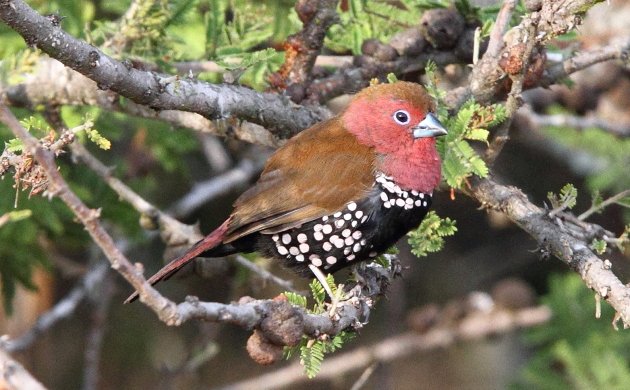
Of course Africa could not to be left out of the pink weekend so I have researched all African species whose official or alternative names include the word “pink”. There are certainly some stunners involved.
Pink-throated Twinspot
Definitely my personal favorite of Africa’s pink birds is the delicate Pink-throated Twinspot. This species is a southern African endemic, restricted to, but fortunately not uncommon, in dry woodland and sand forest habitats of northern Zululand, Swaziland, scattered pockets of north-eastern South Africa and southern Mozambique. Its mostly found on the ground in thickets or the edges of dense vegetation and usually in small family parties. Once their soft trilling call is learnt, they are easily detected. Pink-throated Twinspot’s scientific name is Hypargos margaritatus, the generic name means “possessing 100 eyes below” – “hypo” referring to “under” and “argus” to Argus, the 100-eyed guardian of Io. Margaritatus has an equally romantic connotation, meaning “adorned with pearls”. Both these names as well as it’s English name refer to the overlapping spots that are a feature of the underside of all the twinspots.
The beautiful Pink-throated Twinspot photographed by Adam Riley
Pink-backed Pelican
Africa has two resident pelican species, the huge and widely distributed Great or Eastern White Pelican and the smaller Pink-backed which is restricted to Africa, the southern Arabian peninsula and Madagascar (where it may now be extinct.) Its a pelican that is restricted to freshwaters whereas Great White also enjoys the marine zones. Pink-backed Pelicans build untidy stick nests in tall trees usually near waterbodies but in tropical parts of Africa they even nest in villages and along roadways, as long as they are not persecuted. Africa’s pelicans can be a bit confusing on the identification front as Great White does show an overall pink blush in its plumage during breeding season whereas the pinkest part of Pink-backed Pelican is its lower back, which is only seen in flight!
Pink-backed Pelican by Markus Lilje/Rockjumper Birding Tours
Great White Pelicans showing the pink flush of breeding plumage. Photo by Adam Riley
Pink-breasted Lark
This attractive (for a lark anyway) species is restricted to the dry savannah Somali-Maasai biome of north-east Africa (northern Tanzania, Kenya, southern Ethiopia and Somalia). Its specific preference is arid areas with sandy soils and scattered trees. Pink-breasted Larks are most easily located in the early mornings when males perch prominently atop trees and sing their hearts out. Later they become more difficult as they begin foraging on the ground, usually in pairs. Their pinkish chest streaks are the source of their name.
A pair of Pink-breasted Lark by Markus Lilje/Rockjumper Birding Tours
Pink-billed Lark
Even less pink is the Pink-billed Lark although it is still well named as it sports a prominent pink bill. Another southern African endemic, this species ranges widely across the dry grasslands of central South Africa, Namibia and Botswana. They are nomadic, especially in the non-breeding season and flocks are most easily found at waterholes when they appear to quench their thirst.
Pink-billed Lark by Andrew Stainthorpe/Rockjumper Birding Tours
Pink-footed Puffback
Another not very pink species is the Pink-footed Puffback. This is rather a difficult bird to photograph as its a denizen of the canopy and sub-canopy of Africa’s rainforests. They are however quite widespread and not uncommon, especially when their distinctive call is learnt. Puffbacks belong to the bush-shrike family Malaconotidae and this group are called puffbacks due to several of the species forming a habit of puffing out their fluffy white back feathers during display. This can be very impressive, the Afrikaans name for Black-backed Puffback is “sneeubal” meaning “snowball” as this bird really can look like a puffy snowball when performing its act!
Pink-footed Puffback by Cuan Rush/Rockjumper Birding Tours
Pink-billed Teal
Better know as Cape Teal, this small, pale dabbling duck has a wide range across the more arid areas of subSaharan Africa. They are extremely nomadic and prefer saline waterbodies but are quite catholic in their choices. They usually occur in pairs or small groups but can gather in the thousands when conditions are right – for example when Etosha Pan in Namibia floods. I do prefer the name of Pink-billed rather than Cape Teal – and its more accurate too!
A pair of Pink-billed Teal – better known as Cape Teal by Markus Lilje/Rockjumper Birding Tours
Pink-breasted Dove
This high elevation east African species is now known as Dusky Turtle-Dove. It is found in higher-elevation woodlands from northern Zambia and Malawi northwards through Kenya, Tanzania, Uganda, Ethiopia and Somalia and into the Arabian peninsula. This pattern of distribution of African birds spilling into the southern Arabian peninsula is actually quite a common theme. As a result, southern Arabia is classified into a zone known as the Afrotropics even though it is not physically on the African continent.
Pink-breasted or Dusky Turtle-Dove by Adam Riley
Pink-headed Dove
Formally now known as African Collared-Dove, this dry country species was also called Barbary Dove and can still be found listed as such in certain fieldguides eg in New Zealand where it exists as an introduced bird. It has a wide range across a zone known as the Sahel, an arid zone woodland and savanna region immediately below the Sahara desert stretching from Senegal to Somalia. The African Collared-Dove also ranges into the Arabian Peninsula. African Collared-Dove are also well known for their post breeding dispersal both southwards and northwards so can thus be found in many African countries.
Pink-headed or African Collared-Dove by Markus Lilje/Rockjumper Birding Tours
Pink-throated Longclaw
We end with another of my favorites, now more frequently called Rosy-throated Longclaw. This lovely bird was first collected in Durban from where it is now extinct but it still occurs in northern Zululand and southern Mozambique with other populations in central and east Africa. This bird prefers open, knee-high, seasonally waterlogged grasslands. They can be very difficult to locate but often hover a few feet above the grasslands in breeding season, with their feet hanging down and uttering a “pink-pink” call making it doubly relevant to this pink weekend post!
Pink-throated (or Rosy-throated) Longclaw by Cuan Rush/Rockjumper Birding Tours
…
 It is Pink Bird Weekend on 10,000 Birds! Whether we are discussing birds shaded roseate, fuchsia, rose, coral, salmon, blush, or just plain pink, we have them all covered on Pink Bird Weekend. Why would we bother with such an esoteric topic? To put it simply, pink birds are awesome! Think about it, have you ever seen a pink bird and not wanted to see it again? Of course not! Make sure to check back all Pink Bird Weekend long as we delve into every possible pulchritudinous pink bird we can think of…
It is Pink Bird Weekend on 10,000 Birds! Whether we are discussing birds shaded roseate, fuchsia, rose, coral, salmon, blush, or just plain pink, we have them all covered on Pink Bird Weekend. Why would we bother with such an esoteric topic? To put it simply, pink birds are awesome! Think about it, have you ever seen a pink bird and not wanted to see it again? Of course not! Make sure to check back all Pink Bird Weekend long as we delve into every possible pulchritudinous pink bird we can think of…



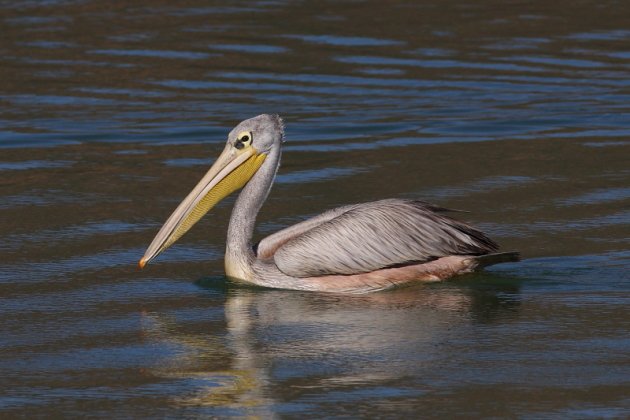
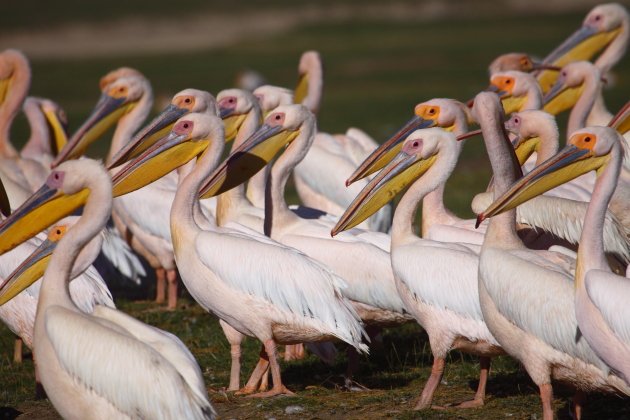
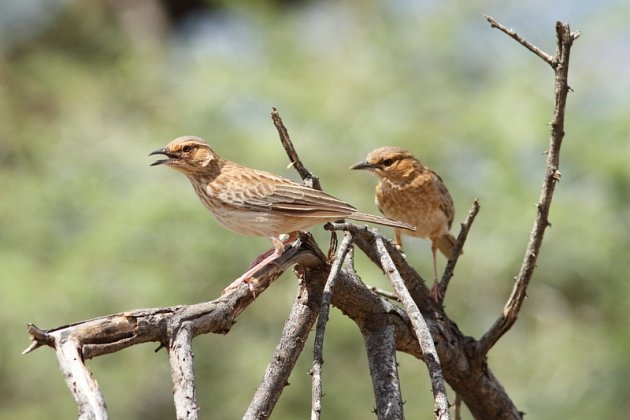
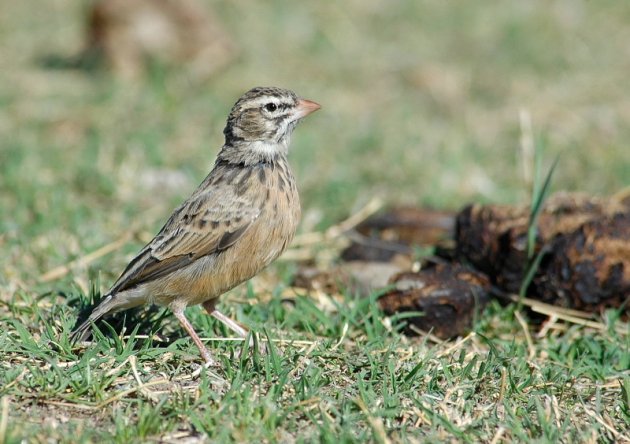
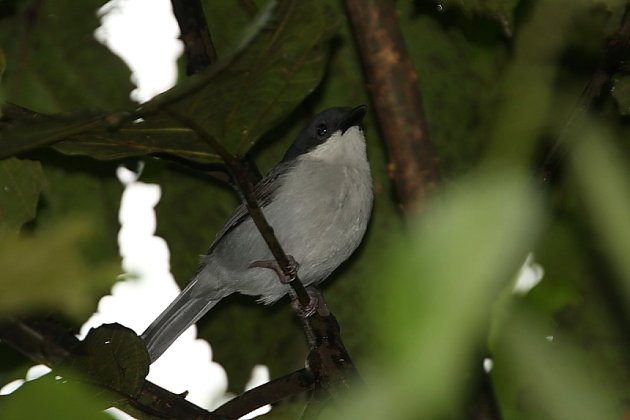
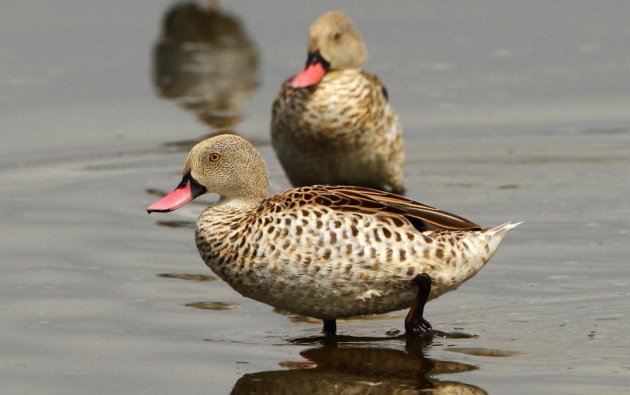
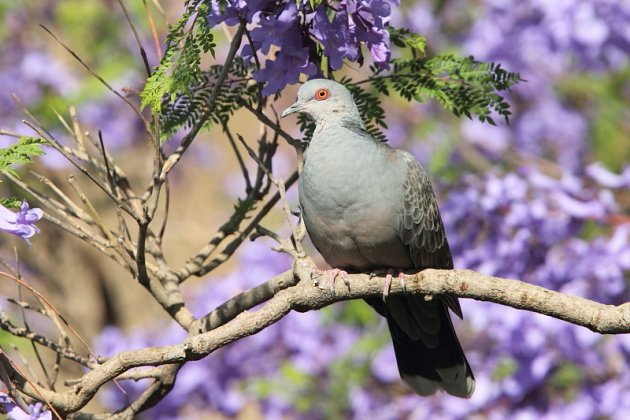
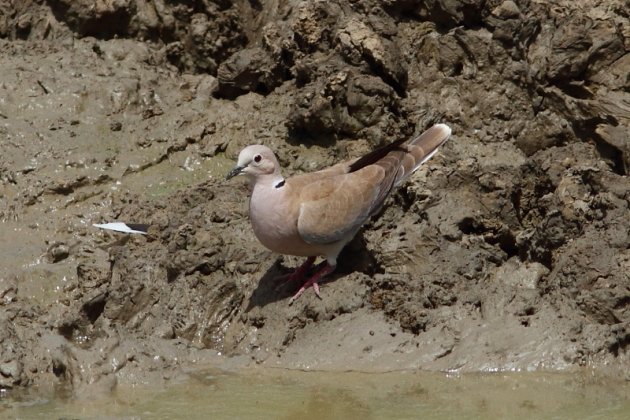
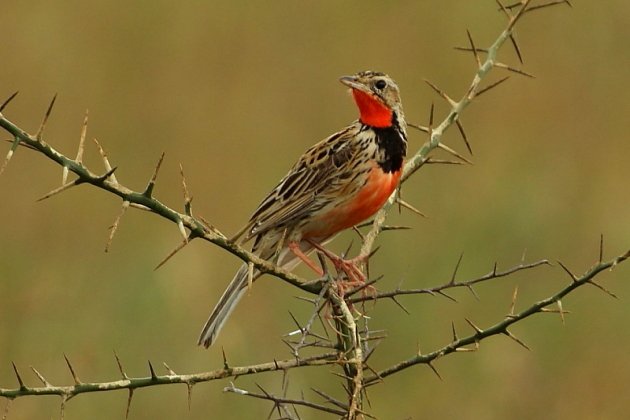











A Pink-billed Teal?!? What an amazing bird! I thought our Ruddy Ducks with their bright blue bills were the strangest ducks of all until I saw your photo!